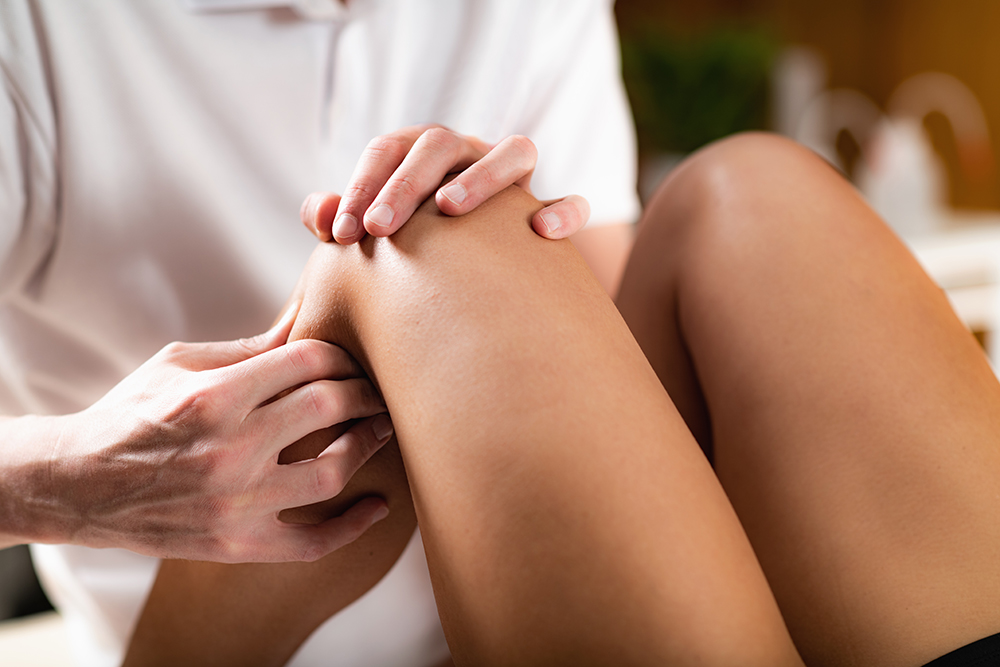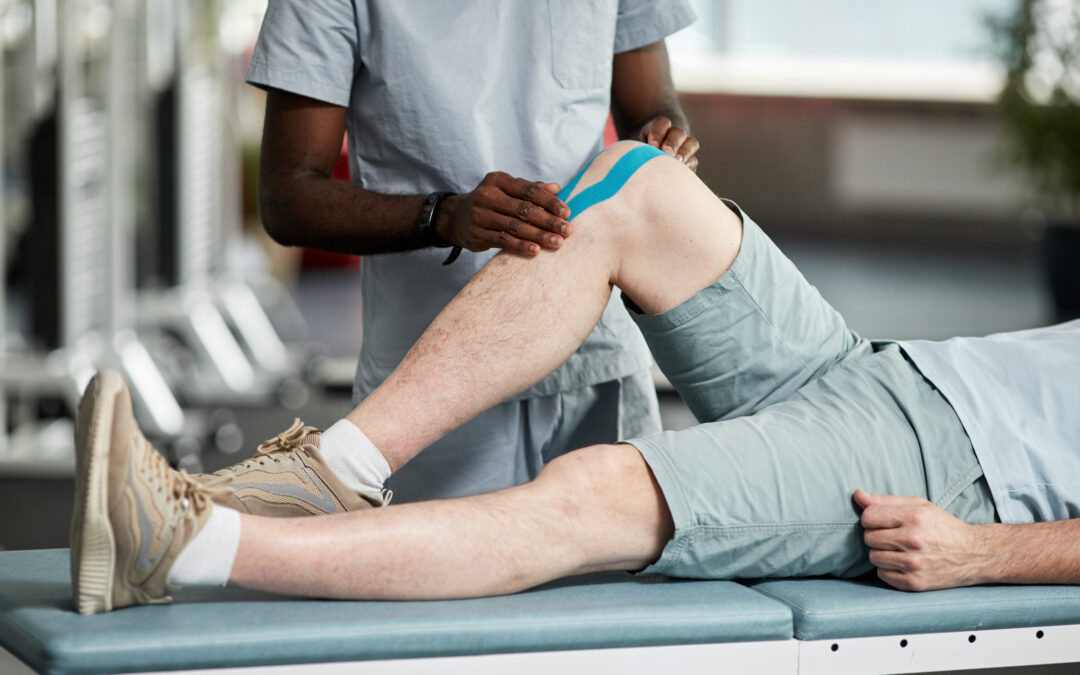Contents
If you’re feeling sharp knee pain, understanding the cause of your pain can be an important step toward finding a solution. Knee pain is a very prevalent symptom — frequent knee pain affects approximately 25% of adults, according to one study. This pain is often accompanied by other symptoms such as stiffness, muscle weakness and swelling. If you’re experiencing persistent sharp pain in your knee, it may be time to seek professional treatment. Physical therapy can be one excellent route. A licensed physical therapist can help identify the cause of your pain, allowing you to receive informed, targeted treatment.
What causes sharp pain in the kneecap? 5 potential causes
Want to learn more about what might be causing your pain? By gaining more knowledge about some potential candidates, you may get more insight into your own condition. Here are some conditions that frequently lead to sharp pain in the kneecap:
- Runner’s knee — Runner’s knee is a condition caused by irritation of the cartilage beneath the kneecap. Also called patellofemoral pain syndrome, this condition is a common cause of pain in the kneecap and surrounding tissue. Runner’s knee is typically caused by sudden injuries or gradual overuse. Repetitive motions that put continual stress on the knee joint, such as running, often lead to this condition, which is why it’s called runner’s knee. If you have runner’s knee, you may notice sharp pain around your kneecap when moving your knee. Movements like running, squatting and jumping may spark especially sharp bursts of pain. Common management methods for runner’s knee include rest, knee bracing and physical therapy.
- Bursitis — If you’re experiencing sharp pain and swelling around your kneecap, the cause could be bursitis. Bursitis is inflammation of the bursae, which are little fluid-filled sacs positioned between joints throughout the body. These sacs provide both cushioning against shock and lubrication against friction from other tissue. When functioning properly, the knee bursae help prevent inflammation and pain. However, the bursae themselves can also become irritated. Bursitis is typically caused by overuse or a direct blunt force impact. Symptoms often include sharp pain, inflammation and a sense of warmth radiating from the knee. The area around your kneecap may also be tender to the touch and appear visibly reddened. If you have knee bursitis, physical therapy can play a crucial role in your recovery. PT treatments such as targeted stretches can be great for reducing the pressure on your knee bursae.
- Jumper’s knee — Jumper’s knee is a common name for patellar tendinitis. Patellar tendinitis happens when the tendon that connects your kneecap to your shin becomes inflamed. If you have patellar tendinitis, you may experience sharp knee pain whenever you put pressure on your knee. You may also feel some stiffness around the knee joint. Patellar tendinitis is generally caused by repetitive movements engaging the knee joint. It’s especially common in athletes who play sports that involve a lot of jumping, such as volleyball and basketball. If you put a lot of stress on your knee without resting properly, you may be at risk of developing jumper’s knee. If you’re already experiencing the symptoms of jumper’s knee, treatment is important. Physical therapy can help you find relief and work toward recovery.
- Kneecap dislocation — Does your knee buckle or give out whenever you try to walk? Is your kneecap visibly out of place? Are you experiencing persistent sharp pain and aching around your kneecap? If you answered yes to these questions, you may have a dislocated kneecap. Kneecap dislocation is not always total. If your knee seems to move in and out of place, you may be experiencing patellar subluxation. This is a partial dislocation. In other cases, the kneecap can fully dislocate. After sustaining an injury that dislocates your kneecap, seeking immediate medical care is crucial for managing your pain and preventing further injury. As you work toward recovery, physical therapy can help you regain your physical capabilities.
- Kneecap fracture — Though the kneecap is dense, it is not impervious to injury. Direct trauma can fracture the kneecap, leading to sharp pain and other symptoms. Kneecap fractures tend to happen suddenly. They often occur in falls, high-impact sports games and motor vehicle accidents. The kneecap serves as a protective shield for the knee joint and the surrounding soft tissue. When it fractures, the rest of the knee becomes highly vulnerable to injury. This makes it very important to seek treatment as soon as possible. Depending on the severity of the fracture, surgery may be necessary. If you’re planning to get surgery for a kneecap fracture, physical therapy can help before and after. Pre- and postsurgery PT can help you avoid surgical complications and facilitate your recovery.
How to treat sharp, stabbing pain in the kneecap that comes and goes
When you’re experiencing sharp pain in your kneecap, finding relief is a top priority. A physical therapist can help identify your condition and offer effective solutions. Physical therapists treat persistent pain with a range of evidence-based techniques. Here are some of the top strategies:
- Strengthening exercises — Knee pain often results from instability. By building strength in the muscles supporting your knee, you can keep your kneecap stable. This may help alleviate your pain and prevent further issues. Your physical therapist can guide you through a range of exercises intended to strengthen your legs. By developing muscles in your calves and thighs, you can improve your weight distribution and reduce strain on your kneecap. Your physical therapist may recommend strengthening exercises such as leg presses and step-ups. Resistance training can also be useful. Ultimately, the most effective exercises will depend on your condition and physical capabilities. Your physical therapist can work with you to develop an exercise program tailored to your needs.
- Aquatic therapy — When you’re experiencing persistent pain, exercising your knee can be hard. You may feel like each movement makes your pain worse. While exercise can be a core part of the recovery process, certain exercises may be counterproductive. An exercise that puts more stress on your knee joint, for example, may actually make your kneecap pain worse. Aquatic therapy can offer the benefits of a workout without putting unwanted pressure on your knee. Aquatic therapy involves engaging in a range of movements and exercises while in a pool. The aquatic environment provides buoyancy, reducing the weight your knee needs to bear. Aquatic therapy can also help alleviate swelling and increase blood flow, which can help accelerate your recovery.
- Manual therapy — Manual therapy tends to play a crucial role in physical therapy treatment. Manual therapy, which refers to hands-on PT treatments, encompasses an array of techniques. Therapeutic stretching, joint manipulation and soft tissue manipulation are a few of the techniques used to address sharp knee pain. In addition to offering pain relief, manual therapy can also relieve tension and improve your knee’s range of motion.
Alleviate your sharp knee pain with Lattimore Physical Therapy
At Lattimore Physical Therapy, our licensed physical therapists are committed to helping you find relief. Whether your knee pain is the result of a sports injury or a chronic health condition, we’ll work with you to find a solution. Our team strives to provide effective, personalized care to each patient. With a range of modalities including manual therapy, exercise and electrical stimulation, you can experience the benefits of a comprehensive treatment plan.
Contact our team today for more information or to schedule an initial appointment.



